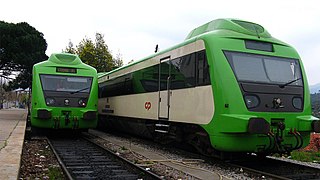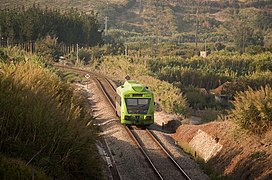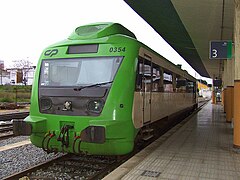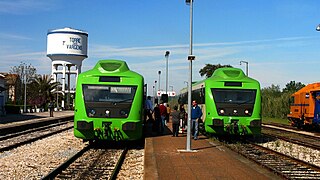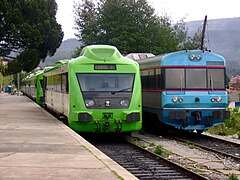CP series 0350
| CP series 0350 | |
|---|---|
|
A type CP – 0350 railcar at km 39.3 at the “Torre das Vargens” station on the Linha do Leste
|
|
| Numbering: | 0351-0371 |
| Number: | 21st |
| Manufacturer: | originally Allan Rotterdam , modernized by EMEF |
| Year of construction (s): | originally 1954–55, modernized 1999–2000 |
| Axis formula : | Bo'-bo ' |
| Gauge : | 1668 mm |
| Length: | 23.63 meters |
| Empty mass: | 52.8 t |
| Top speed: | 100 km / h |
| Installed capacity: | 252 kW |
| Drive: | 2 engines Poyaud C.615OT |
| Operating mode: | Diesel-electric |
| Seats: | 64 |
| Standing room: | 80 |
| Classes : | 1 |
The 0350 series is a one-piece diesel multiple unit operated by the Portuguese State Railways Comboios de Portugal (CP). It represents a modernization of the previous 0300 series and has been used primarily in local and regional traffic on Portuguese branch lines since 2000.
history

In the mid-1990s, the 0300 series diesel multiple units previously used on the Ramal de Lousã, produced in the 1950s, were seen as getting on in years and no longer meeting the usual standards. Due to their age and their slow speed, they were even considered a symbol of the poor image of the Portuguese railways. Since the Portuguese state railway Caminhos de Ferro Portugueses (CP) had limited financial resources, it was not possible to purchase new vehicles. For this reason, CP decided in 1998 to commission the subsidiary EMEF to completely overhaul 21 of the original 25 railcars of the 0300 series. The total cost of the project was a good two billion Portuguese escudos, a good 100,000,000 escudos (€ 500,000) per vehicle. For new vehicles, the CP counted on four times the price.
The extensive modernization took place in the EMEF plants in Guifões , near Porto. Outside, the vehicles were given a new green-beige color scheme, while the walls inside were given the color blue. Furthermore, EMEF brought the cars up to the state of the art at the time, which included air conditioning, double glazed panoramic windows, automatic doors, vandalism-resistant materials and a closed toilet system. The train driver received an on-board computer with a centralized error reporting system for the first time. The train classes were abolished, a unit class offered space for 144 passengers, 64 to 68 seats. With the modernization, the life of the vehicles has been extended by 15 to 20 years, according to the CP.
The original delivery should take place from September 1999. After the decision to also completely replace the electrical part, delivery was delayed by two months to November. From November, the EMEF delivered two vehicles per month. In the run-up to the 1999 parliamentary elections , an early presentation of the first vehicle took place in Coimbra on October 8th.
commitment
From the outset, the range of use of the series was limited to the center and south of the Portuguese rail network. The wagons were used in particular on the Ramal da Lousã , Ramal da Figueira da Foz and Linha do Oeste railway lines . Other routes were the Ramal de Cáceres , Linha do Leste and Linha da Beira Baixa .
Two factors led to the fact that the area of operation was noticeably reduced: gradually, the infrastructure operator Refer had to close branch lines due to financing problems ( Ramal da Figueira da Foz , Ramal de Cáceres ), on the other hand, lines were electrified ( Linha da Beira Baixa ). Today the railcars are only used on the Linha do Oeste and occasionally on the Linha do Alentejo between Beja and Vila Nova de Baronia .
Web links
- Detailed PDF on the history of the 0450 series (PDF file, 860 kB, Portuguese)
- Brief information on the CP series 0350 (Portuguese)
Individual evidence
- ↑ Carlos Cipriano: Automotoras vermelhas já foram azuis . In: Público . December 22, 1999 (Portuguese).
- ↑ Two copies burned down, one vehicle was converted into a VIP vehicle, one copy went to the Railway Museum
- ^ A b Carlos Cipriano: Comboios reciclados en Coimbra . In: Público . December 22, 1999 (Portuguese).
- ^ A b Alvaro Vieira and Ana Cristina Gomes: Enquanto o Metro not chega a Coimbra . In: Público . October 8, 1999 (Portuguese).

